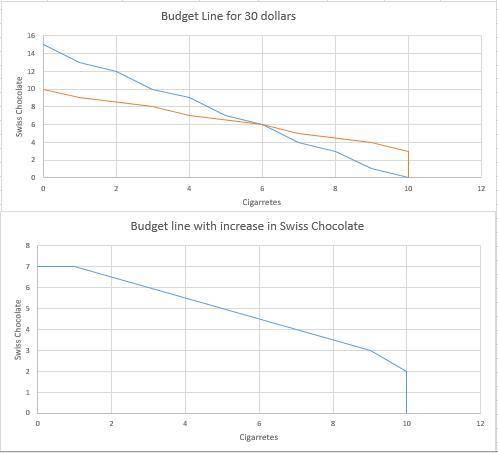
Business, 23.01.2020 00:31 avasteinhebel10
You are waiting to board at an airport for a trip to korea. you decided to buy cigarettes and swiss chocolates for your friends at a shop in the airport. you have $30 only. a price for one pack of cigarettes is $2 and a price for one bar of swiss chocolates is $3. you also learned from a traveller's book that you can only bring 10 packs of cigarettes into the country at the maximum and are not allowed to buy more than that ("cigarettes rationing").
write down the budget set and budget line in equations for the case without regulation on cigarettes amount.
draw a budget line for each of two cases in a same graph: without the regulation on cigarettes amount and with the regulation in place. put swiss chocolates on the y axis and cigarettes on the x axis. label x and y intercepts.
suppose the price of a bar of swiss chocolates increases to $4 due to an increase in cocoa powder. draw a new budget line with the cigarettes rationing under the new price in the same graph.
can you afford an bundle (cigarettes = 7 packs, chocolates = 5 bars) under the old price of chocolates (i. e. p_2 = 3)? how about under the new price of chocolates (i. e. p_2 = 4)?

Answers: 2


Another question on Business


Business, 22.06.2019 10:10
Rats that received electric shocks were unlikely to develop ulcers if the
Answers: 1

Business, 22.06.2019 11:40
Zachary company produces commercial gardening equipment. since production is highly automated, the company allocates its overhead costs to product lines using activity-based costing. the costs and cost drivers associated with the four overhead activity cost pools follow: activities unit level batch level product level facility level cost $ 64,800 $ 27,730 $ 15,000 $ 154,000 cost driver 2,400 labor hrs. 47 setups percentage of use 11,000 units production of 780 sets of cutting shears, one of the company’s 20 products, took 240 labor hours and 7 setups and consumed 15 percent of the product-sustaining activities. required: (a) had the company used labor hours as a company wide allocation base, how much overhead would it have allocated to the cutting shears? (b) how much overhead is allocated to the cutting shears using activity-based costing? (c) compute the overhead cost per unit for cutting shears first using activity-based costing and then using direct labor hours for allocation if 780 units are produced. if direct product costs are $150 and the product is priced at 30 percent above cost for what price would the product sell under each allocation system? (d) assuming that activity-based costing provides a more accurate estimate of cost, indicate whether the cutting shears would be over- or underpriced if direct labor hours are used as an allocation base. explain how over-or undercosting can affect vaulker's profitability. (e) comment on the validity of using the allocated facility-level cost in the pricing decision. should other costs be considered in a cost- plus pricing decision? if so, which ones? what costs would you include if you were trying to decide whether to accept a special order?
Answers: 1

Business, 22.06.2019 12:20
Consider 8.5 percent swiss franc/u.s. dollar dual-currency bonds that pay $666.67 at maturity per sf1,000 of par value. it sells at par. what is the implicit sf/$ exchange rate at maturity? will the investor be better or worse off at maturity if the actual sf/$ exchange rate is sf1.35/$1.00
Answers: 2
You know the right answer?
You are waiting to board at an airport for a trip to korea. you decided to buy cigarettes and swiss...
Questions

Chemistry, 20.04.2020 17:09

Mathematics, 20.04.2020 17:10


Mathematics, 20.04.2020 17:10



Mathematics, 20.04.2020 17:10

History, 20.04.2020 17:10

Mathematics, 20.04.2020 17:10

Mathematics, 20.04.2020 17:10



Mathematics, 20.04.2020 17:11

Mathematics, 20.04.2020 17:11


English, 20.04.2020 17:11

Mathematics, 20.04.2020 17:11


Mathematics, 20.04.2020 17:11




